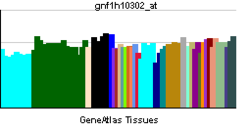- OR51E1
-
Olfactory receptor, family 51, subfamily E, member 1 Identifiers Symbols OR51E1; D-GPCR; FLJ13581; GPR136; GPR164; MGC24137; OR51E1P; OR52A3P; POGR; PSGR2 External IDs OMIM: 611267 MGI: 3030392 HomoloGene: 17503 GeneCards: OR51E1 Gene Gene Ontology Molecular function • receptor activity
• olfactory receptor activityCellular component • plasma membrane
• integral to membraneBiological process • sensory perception of smell
• response to stimulusSources: Amigo / QuickGO RNA expression pattern 
More reference expression data Orthologs Species Human Mouse Entrez 143503 259097 Ensembl ENSG00000180785 ENSMUSG00000070423 UniProt Q8TCB6 n/a RefSeq (mRNA) NM_152430 NM_147093.3 RefSeq (protein) NP_689643 NP_667304.1 Location (UCSC) Chr 11:
4.66 – 4.68 MbChr 7:
109.85 – 109.86 MbPubMed search [1] [2] Olfactory receptor 51E1 is a protein that in humans is encoded by the OR51E1 gene.[1]
Olfactory receptors interact with odorant molecules in the nose, to initiate a neuronal response that triggers the perception of a smell. The olfactory receptor proteins are members of a large family of G-protein-coupled receptors arising from single coding-exon genes. Olfactory receptors share a 7-transmembrane domain structure with many neurotransmitter and hormone receptors and are responsible for the recognition and G protein-mediated transduction of odorant signals. The olfactory receptor gene family is the largest in the genome. The nomenclature assigned to the olfactory receptor genes and proteins for this organism is independent of other organisms.[1]
Contents
See also
References
Further reading
- Wang J, Weng J, Cai Y, et al. (2006). "The prostate-specific G-protein coupled receptors PSGR and PSGR2 are prostate cancer biomarkers that are complementary to alpha-methylacyl-CoA racemase". Prostate 66 (8): 847–57. doi:10.1002/pros.20389. PMID 16491480.
- Weng J, Wang J, Hu X, et al. (2007). "PSGR2, a novel G-protein coupled receptor, is overexpressed in human prostate cancer". Int. J. Cancer 118 (6): 1471–80. doi:10.1002/ijc.21527. PMID 16206286.
- Gerhard DS, Wagner L, Feingold EA, et al. (2004). "The status, quality, and expansion of the NIH full-length cDNA project: the Mammalian Gene Collection (MGC)". Genome Res. 14 (10B): 2121–7. doi:10.1101/gr.2596504. PMC 528928. PMID 15489334. http://www.pubmedcentral.nih.gov/articlerender.fcgi?tool=pmcentrez&artid=528928.
- Weigle B, Fuessel S, Ebner R, et al. (2004). "D-GPCR: a novel putative G protein-coupled receptor overexpressed in prostate cancer and prostate". Biochem. Biophys. Res. Commun. 322 (1): 239–49. doi:10.1016/j.bbrc.2004.07.106. PMID 15313197.
- Malnic B, Godfrey PA, Buck LB (2004). "The human olfactory receptor gene family". Proc. Natl. Acad. Sci. U.S.A. 101 (8): 2584–9. doi:10.1073/pnas.0307882100. PMC 356993. PMID 14983052. http://www.pubmedcentral.nih.gov/articlerender.fcgi?tool=pmcentrez&artid=356993.
- Vanti WB, Nguyen T, Cheng R, et al. (2003). "Novel human G-protein-coupled receptors". Biochem. Biophys. Res. Commun. 305 (1): 67–71. doi:10.1016/S0006-291X(03)00709-5. PMID 12732197.
- Strausberg RL, Feingold EA, Grouse LH, et al. (2003). "Generation and initial analysis of more than 15,000 full-length human and mouse cDNA sequences". Proc. Natl. Acad. Sci. U.S.A. 99 (26): 16899–903. doi:10.1073/pnas.242603899. PMC 139241. PMID 12477932. http://www.pubmedcentral.nih.gov/articlerender.fcgi?tool=pmcentrez&artid=139241.
- Adams MD, Kerlavage AR, Fleischmann RD, et al. (1995). "Initial assessment of human gene diversity and expression patterns based upon 83 million nucleotides of cDNA sequence" (PDF). Nature 377 (6547 Suppl): 3–174. PMID 7566098. http://www.columbia.edu/itc/biology/pollack/w4065/client_edit/readings/nature377_3.pdf.
External links
This article incorporates text from the United States National Library of Medicine, which is in the public domain.
Class II
(tetrapod specific receptors)Family 1Family 2A1 · A2 · A4 · A5 · A7 · A12 · A14 · A25 · A42 · AE1 · AG1 · AG2 · AJ1 · AK2 · AP1 · AT4 · B2 · B3 · B6 · B8 · B11 · C1 · C3 · D2 · D3 · F1 · F2 · G2 · G3 · G6 · H1 · H2 · J1 · J2 · J3 · K2 · L2 · L3 · L5 · L8 · L13 · M2 · M3 · M4 · M5 · M7 · S2 · T1 · T2 · T3 · T4 · T5 · T6 · T8 · T10 · T11 · T12 · T27 · T29 · T33 · T34 · T35 · V1 · V2 · W1 · W3 · W5 · Y1 · Z1
Family 3Family 4Family 5Family 6Family 7Family 8Family 9Family 10Family 11Family 12Family 13Categories:- Human proteins
- Transmembrane receptor stubs
- G protein coupled receptors
Wikimedia Foundation. 2010.
